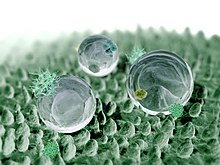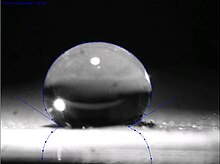
Back تأثير زهرة اللوتس Arabic Lotos effekti Azerbaijani Ефект на лотоса Bulgarian Efecte lotus Catalan Lotosový efekt Czech Lotoseffekt German Lotusa efiko Esperanto Efecto loto Spanish اثر لوتوس Persian Effet lotus French




The lotus effect refers to self-cleaning properties that are a result of ultrahydrophobicity as exhibited by the leaves of Nelumbo, the lotus flower.[1] Dirt particles are picked up by water droplets due to the micro- and nanoscopic architecture on the surface, which minimizes the droplet's adhesion to that surface. Ultrahydrophobicity and self-cleaning properties are also found in other plants, such as Tropaeolum (nasturtium), Opuntia (prickly pear), Alchemilla, cane, and also on the wings of certain insects.[2]
The phenomenon of ultrahydrophobicity was first studied by Dettre and Johnson in 1964[3] using rough hydrophobic surfaces. Their work developed a theoretical model based on experiments with glass beads coated with paraffin or PTFE telomer. The self-cleaning property of ultrahydrophobic micro-nanostructured surfaces was studied by Wilhelm Barthlott and Ehler in 1977,[4] who described such self-cleaning and ultrahydrophobic properties for the first time as the "lotus effect"; perfluoroalkyl and perfluoropolyether ultrahydrophobic materials were developed by Brown in 1986 for handling chemical and biological fluids.[5] Other biotechnical applications have emerged since the 1990s.[6][7][8][9][10][11]
- ^ Lafuma, A.; Quere, D. (2003). "Superhydrophobic states". Nature Materials. 2 (7): 457–460. Bibcode:2003NatMa...2..457L. doi:10.1038/nmat924. PMID 12819775. S2CID 19652818.
- ^ Barthlott, W. (2023): “The Discovery of the Lotus Effect as a Key Innovation for Biomimetic Technologies” - in: Handbook of Self-Cleaning Surfaces and Materials: From Fundamentals to Applications, Chapter 15, pp. 359-369 - Wiley-VCH, https://doi.org/10.1002/9783527690688.ch15
- ^ Rulon E. JohnsonJr.; Robert H. Dettre (1964). "Contact Angle Hysteresis. III. Study of an Idealized Heterogeneous Surface". J. Phys. Chem. 68 (7): 1744–1750. doi:10.1021/j100789a012.
- ^ Barthlott, Wilhelm; Ehler, N. (1977). "Raster-Elektronenmikroskopie der Epidermis-Oberflächen von Spermatophyten". Tropische und Subtropische Pflanzenwelt. 19: 110.
- ^ Brown Laboratory vessel having hydrophobic coating and process for manufacturing same Archived 2017-01-22 at the Wayback Machine U.S. patent 5,853,894, Issued December 29, 1998
- ^ Barthlott, Wilhelm; C. Neinhuis (1997). "The purity of sacred lotus or escape from contamination in biological surfaces". Planta. 202: 1–8. doi:10.1007/s004250050096. S2CID 37872229.
- ^ Barthlott, W., Mail, M., Bhushan, B., & K. Koch. (2017). Plant Surfaces: Structures and Functions for Biomimetic Innovations. Nano-Micro Letters, 9(23), doi:10.1007/s40820-016-0125-1.
- ^ Cheng, Y. T.; Rodak, D. E. (2005). "Is the lotus leaf superhydrophobic?". Appl. Phys. Lett. 86 (14): 144101. Bibcode:2005ApPhL..86n4101C. doi:10.1063/1.1895487.
- ^ Narhe, R. D.; Beysens, D. A. (2006). "Water condensation on a super-hydrophobic spike surface". Europhys. Lett. 75 (1): 98–104. Bibcode:2006EL.....75...98N. doi:10.1209/epl/i2006-10069-9.
- ^ Lai, S.C.S. "Mimicking nature: Physical basis and artificial synthesis of the Lotus effect" (PDF). Archived from the original (PDF) on 2007-09-30.
- ^ Koch, K.; Bhushan, B.; Barthlott, W. (2008). "Diversity of structure, Morphology and Wetting of Plant Surfaces. Soft matter". Soft Matter. 4 (10): 1943. Bibcode:2008SMat....4.1943K. doi:10.1039/b804854a.